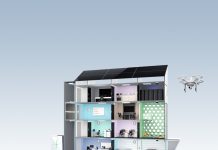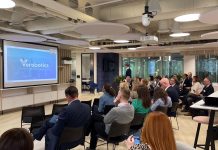Smart technology is a familiar term, but what does “smart” really mean – and how can designers, builders and engineers harness the benefits for both new and existing buildings? Francesco Anselmo, associate director at Arup, takes a look
If we were to design buildings to harness the power of modern technology, rather than accepting legacy approaches, how would these smart buildings look and what benefits would they bring to the people who use them? Perhaps more importantly, given that up to 87% of today’s buildings will still be occupied in 2050, how can we deliver similar benefits in existing buildings.
At Arup, we are passionate about smart, exploring how technological disruption is creating environments that enhance human experience and asset performance.
Defining the meaning of smart
In recent decades, “smart” has been increasingly used to describe almost any new piece of technology, but smart buildings are more than isolated items of kit or software – they have a profound and positive impact on the people and businesses who use them.
A smart building should deliver on three key criteria:
- Enabling connectivity between diverse building service systems, business systems, control interfaces and personal devices.
- Automatically identifying issues and using machine learning to operate buildings more efficiently and effectively, including resources such as energy and space.
- Supporting the health and happiness of occupants through environments that are productive and comfortable.
The benefits of smart
Smart buildings bring together real-time data and system controls to optimise asset performance and improving resource efficiency, moving towards predictive maintenance and responding to the climate emergency.
Building users can access enhanced services, from amenity bookings to on-demand services such as catering and parcel deliveries. Employees can easily find suitable work areas via their personal devices, be it a collaborative space for team activities or a quiet desk for individual focus. The visitor experience is also easier, quicker and more enjoyable.
For occupiers, smart enhancements support commercial performance – research shows that people’s productivity increases when they are more comfortable and have greater control over their work environment.
For property owners, smart buildings stand out in a crowded marketplace, providing a premium that boosts lettability in a similar way to wellness certifications. Proactive diagnostics allow facilities teams to detect and fix maintenance issues before occupiers are affected, improving relationships.
In addition, live occupancy data opens opportunities for new pricing models such as space-as-a-service or demand-driven pricing. Owners can also draw on real-time data about how spaces and services are being used, to adapt their portfolios to the changing needs of occupiers.
Enabling buildings for diverse futures
With new technologies rapidly emerging and work practices evolving, how can we prepare the first generation of smart buildings for futures that might not even have been imagined yet? For a start, it is not dependent on significant capital expenditure during the base build. Through good design, procurement and testing, any new and many existing buildings can be smart-enabled.
Smart enablement involves standardising the naming of building devices, open internet standard communication protocols, common networking and data validation. These are the first steps towards commercially viable smart buildings, enabling many of the benefits without having to immediately introduce costly features that could become redundant or not suit future occupier requirements.
At British Land’s 1 Finsbury Avenue, a major refurbishment project engineered by Arup with AHMM architects, we enabled smart at a relatively late design stage, working with both the existing base build and new fit-out systems. Through understanding the data requirements and communication protocols, we added specifications to existing systems and designs, introducing digital functionalities without significant changes and with minimal cost implications.
We worked with British Land in facilitated workshops to develop use cases and associated user journeys across several projects in their portfolio. Through use case mapping, we ensured our fit-out guidelines cover all the necessary read/write points that need to be exposed from building systems, sensors and other technologies, futureproofing any building within the portfolio.
Unlocking the power of new technology
Building data is currently structured in many ways. The lack of standardised naming for connected devices in the built environment has been a huge barrier to collecting, analysing and capturing data insights from buildings.
We are collaborating with industry partners to pioneer new standards for the automation and retrieval of real-time data from building systems and sensor networks. Partnering with the Open Data Institute, British Land and Google, we have developed a Building Device Naming Standard – an open-source standard already implemented across multiple projects. This will be a catalyst for optimising building efficiency and occupant productivity.
To further realise the potential of smart buildings, we are researching, developing and working hands-on with Internet of Things (IoT) and maker technologies, both with our clients and within our own organisation. We have invested in a global IoT skills community, which has also yielded a smart desk project, new technical specifications and lab and maker spaces.
Leading by example, we are deploying our open, secure IoT approach in our existing London head office at 8 Fitzroy Street and our new home at 80 Charlotte Street. Both buildings are connected to our Property Insight platform, which is transforming how we use our space, providing our operational teams with actionable insights to create a better experience for our people and achieve our sustainability objectives.
Other digital tools we have developed include Arup Carbon, which automates embodied carbon calculations from complex geometric models, and Space Explorer, which is helping clients shape their workplaces for productivity and wellbeing.
Looking ahead
Whether new or existing, futureproofing buildings is at the top of our agenda and utilising the power of smart remains key to that. We are helping developers, designers and occupiers make better use of diverse data to enable better human experiences and improve performance. Together, we are shaping a smarter future, ensuring the resilience of our towns and cities of tomorrow.
Francesco Anselmo
Associate director
Tel: +44 (0) 20 7636 1531
Twitter: @arupgroup
LinkedIn: arup
Instagram: arupgroup

















